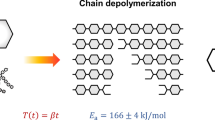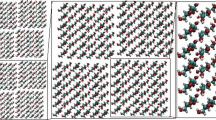Abstract
Thermo-compression process—compression of pure cellulose under high temperatures and pressures—is a recent method to produce biodegradable materials. For such processes, experimental measurements and study of properties and behavior of cellulose are difficult to carry out. To overcome these difficulties, a complete pressure–volume–temperature investigation is needed as carried out in this work. To develop a predictive thermodynamic PVT model of cellulose theoretically, the modified Sanchez and Lacombe equation of state together with the implementation of the Hoftyzer and van Krevelen group contribution method and the Boudouris modification to the Constantinou and Gani’s group contribution method were coupled to the Compressible Regular Solution theory. The developed method is a pure predictive model and to examine the accuracy of theoretically calculated PVT data by the model, some available PVT data of cellulose at temperatures from 25 to 180 °C and pressures from 19.6 to 196 MPa (219 data points) were collected from literature. The comparisons were made and the agreement between the calculations and the experimental data were acceptable with a Cumulative Absolute Relative Deviation of 0.04 %. Consequently, the model can be used for prediction of thermodynamic properties of cellulose and cellulose-containing mixtures.




Similar content being viewed by others
References
Boudouris D, Constantinou L, Panayiotou C (1997) A group contribution estimation of the thermodynamic properties of polymers. Ind Eng Chem Res 36:3968–3973. doi:10.1021/ie970242g
Jallabert B, Vaca-Medina G, Cazalbou S, Rouilly A (2013) The pressure–volume–temperature relationship of cellulose. Cellulose 20:2279–2289. doi:10.1007/s10570-013-9986-3
Keshavarz L, Khansary MA, Shirazian S (2015) Phase diagram of ternary polymeric solutions containing nonsolvent/solvent/polymer: theoretical calculation and experimental validation. Polymer 73:1–8. doi:10.1016/j.polymer.2015.07.027
Nilsson H, Galland S, Larsson PT, Gamstedt EK, Nishino T, Berglund LA, Iversen T (2010) A non-solvent approach for high-stiffness all-cellulose biocomposites based on pure wood cellulose. Compos Sci Technol 70:1704–1712. doi:10.1016/j.compscitech.2010.06.016
Nishiyama Y, Langan P, Chanzy H (2002) Crystal structure and hydrogen-bonding system in cellulose Iβ from synchrotron X-ray and neutron fiber diffraction. J Am Chem Soc 124:9074–9082. doi:10.1021/ja0257319
Pintiaux T, Viet D, Vandenbossche V, Rigal L, Rouilly A (2013) High pressure compression-molding of α-cellulose and effects of operating conditions. Materials 6:2240
Poling BE, Prausnitz JM, O’Connell JP (1987) Properties of gases and liquids, 4th edn. McGraw-Hill Professional, New York
Ruzette A-VG, Mayes AM (2001) A simple free energy model for weakly interacting polymer blends. Macromolecules 34:1894–1907. doi:10.1021/ma000712+
Sanchez I, Stone M (2000) Statistical thermodynamics of polymer solutions and blends volume 1: formulation. Polymer blends: formulation and performance. Wiley, New York
Sandler SI (1993) Models for thermodynamic and phase equilibria calculations chemical industries. CRC Press, Boca Raton
Vaca-Medina G, Jallabert B, Viet D, Peydecastaing J, Rouilly A (2013) Effect of temperature on high pressure cellulose compression. Cellulose 20:2311–2319. doi:10.1007/s10570-013-9999-y
van Krevelen DW, Nijenhuis KT (2008) Properties of polymers: their correlation with chemical structure; their numerical estimation and prediction from additive group contributions, chapter 7, 4th edn. Elsevier, Philadelphia, p 215
Zhang X, Wu X, Gao D, Xia K (2012) Bulk cellulose plastic materials from processing cellulose powder using back pressure-equal channel angular pressing. Carbohydr Polym 87:2470–2476. doi:10.1016/j.carbpol.2011.11.019
Acknowledgments
The authors gratefully acknowledge the important contribution and guidance provided by Al French (Editor-in-Chief in Cellulose) regarding the chemical structure of cellulose repeating unit.
Author information
Authors and Affiliations
Corresponding author
Rights and permissions
About this article
Cite this article
Asgarpour Khansary, M., Shirazian, S. Theoretical modeling for thermophysical properties of cellulose: pressure/volume/temperature data. Cellulose 23, 1101–1105 (2016). https://doi.org/10.1007/s10570-016-0888-z
Received:
Accepted:
Published:
Issue Date:
DOI: https://doi.org/10.1007/s10570-016-0888-z




